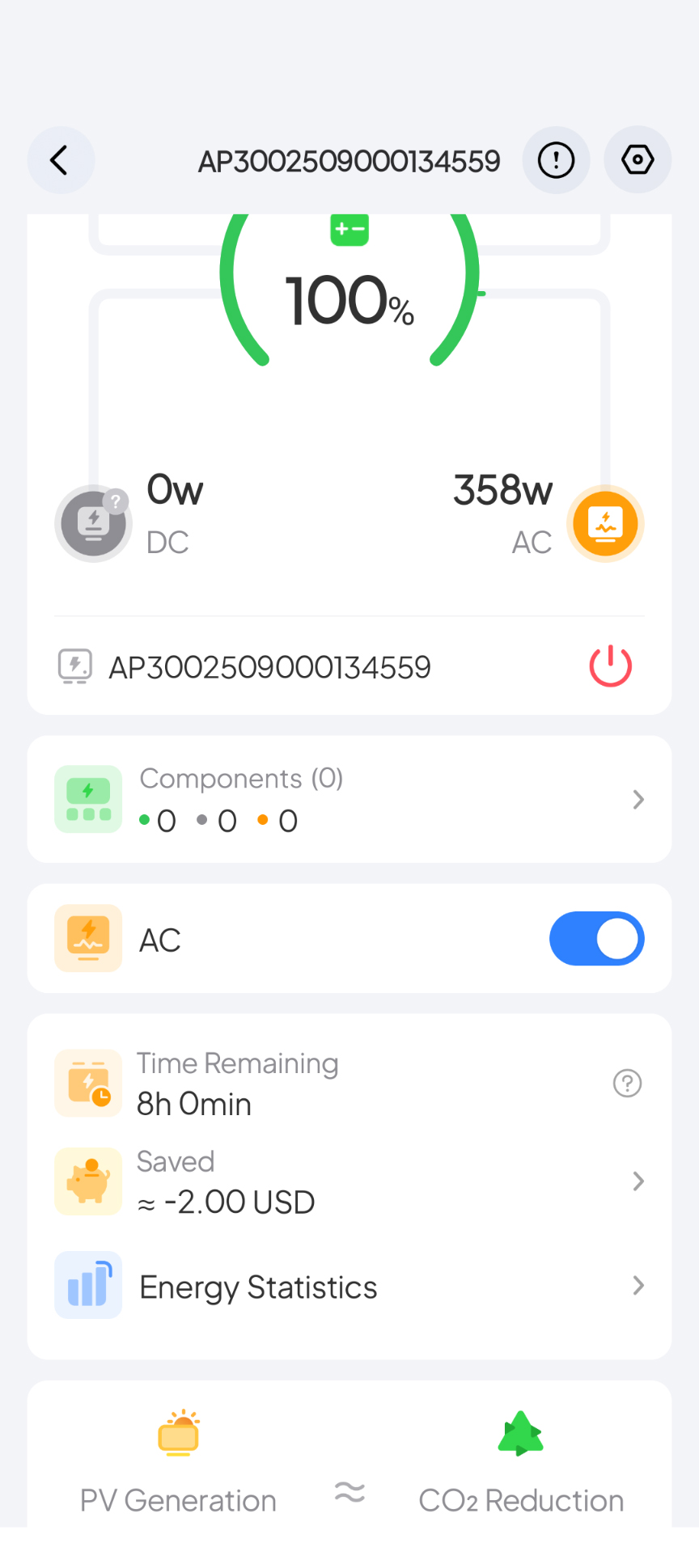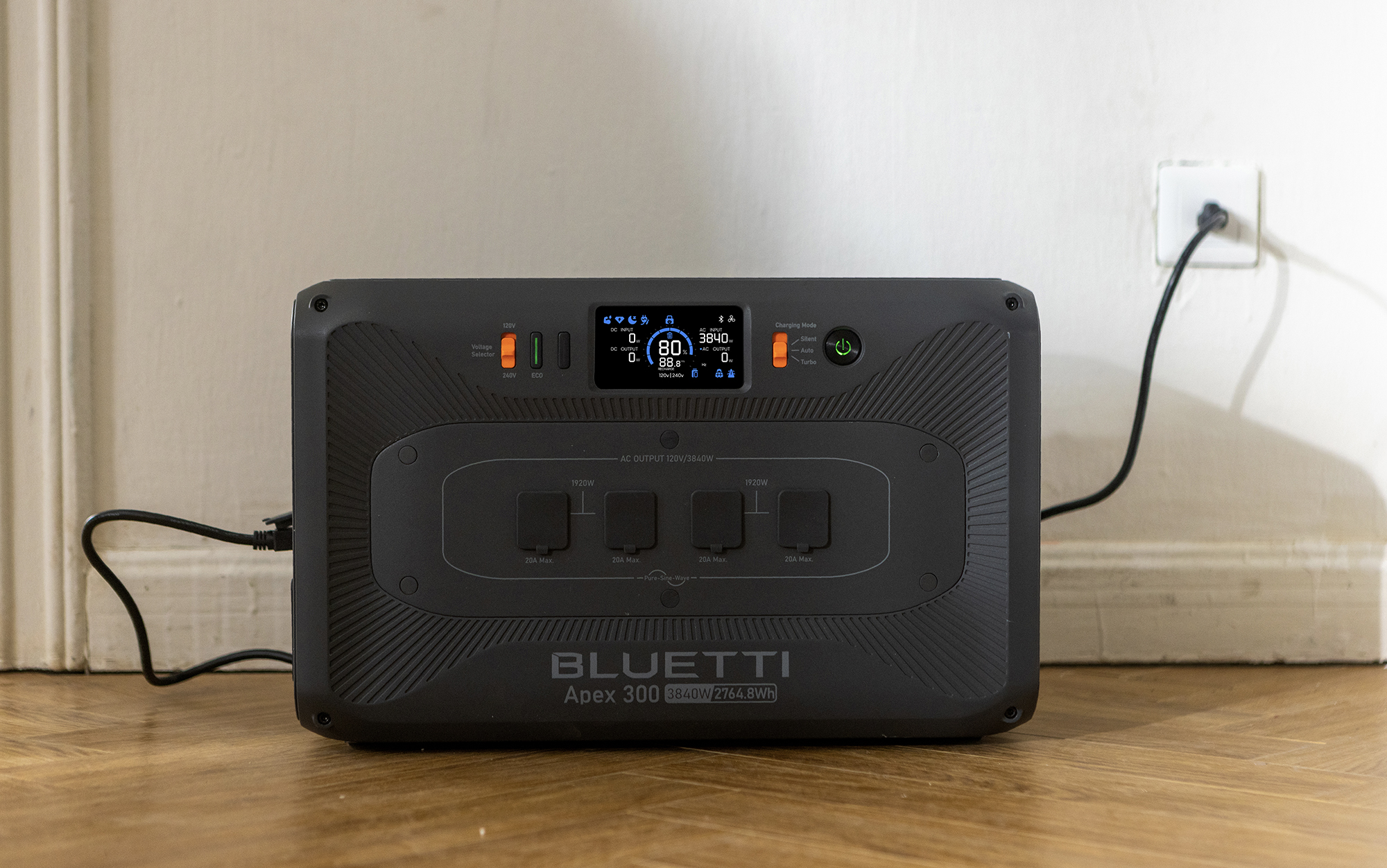Bluetti Apex 300: The Latest Entry in the Stackable Power Station Wars
We may earn revenue from the products available on this page and participate in affiliate programs. Learn More ›
Between outages and freak storms, the reliability of the power grid to keep the lights on has been getting dicey over the last several years. So more and more people are equipping themselves with power stations before the next blackout hits. But it’s hard to figure out how much power you need from a power station — few of us know how much energy our refrigerator needs to run for 24 hours let alone the rest of our home. To say nothing of how long the blackout will last in the first place.
Enter stackable power stations. The idea here is that you purchase one power station that has the relevant ports and displays for your needs, but then bolster it with a bunch of power stations whose sole purpose is to hold and discharge power to the main unit. Because these other power stations are nothing more than a battery — and cannot be used on their own — they take up a lot less room and cost a ton less than their counterparts. If you end up needing more power for your home, you can just add another expansion battery, no need to replace your whole setup. Anker and Goal Zero already have their own versions of this concept, and now Bluetti is in the game with the Apex 300. I was able to test a unit before its release for preorder.
Key Features of the Bluetti Apex 300
- Main Battery Capacity: 2,764.8 Wh
- Battery Type: LiFePO4
- Life Cycles: 6,000 to 80% Capacity
- Outlets: 4 AC (1920W max per pair of ports), NEMA TT-30R (3600W max), NEMA L14-50R (840W max)
- Option to add a DC hub for additional USB and car charger ports
- Dual Voltage: 120V/240V
- Solar Input: 1200W per port, 2400W total
- Uninterruptible Power Supply (UPS) Switchover: 0 milliseconds
- Weight: 83.7 pounds
- Warranty: 5 years
- Compatible app
I’ve tested a number of portable power stations, which can keep your laptop or smartphone running during an extended power outage, but not much else, so I was curious to check out how a scalable system like the Bluetti Apex 300 compares to those units. Here are the most important differences.
Compatibility with the B300K
The vast majority of portable power stations are standalone units, but the Apex 300 is compatible with Bluetti’s B300K, which is half the size, and way less expensive. The Apex 300 (with AC ports and a display screen) stacks on top of the B300Ks. You then plug them together to extend the energy potential of your power station to whatever you need.
Ports
Unlike the power stations I’ve tested in the past, there is no DC charging, including USB and car charger ports, on the Bluetti Apex 300. Instead, there are 4 AC ports that can, all together, handle nearly 4,000 watts of output. That’s massive. A floor lamp is using somewhere between 60 and 100 watts. Even a microwave is only using around 1,000 watts. Whereas with other power stations you have to be a little thoughtful to make sure you aren’t overloading the unit with demand, you would be hardpressed to overload this one.
In addition to the 4 AC ports, the Bluetti Apex 300 also has a NEMA TT-30R port and a NEMA L14-50R port. The former is compatible with many RVs, while the latter is compatible with RVs and, notably, electric cars.
Charge an Electric Car
This is the first power station I’ve tested that boasts being able to charge an electric car. While I do not have an electric car, it’s worth noting what you can expect this power station to be able to realistically do. Just eyeballing this unit, you can see that it’s smaller than the batteries that are powering electric cars. So there’s not a full charge here. If you completely drained this battery into your car, you’d get maybe a quarter of a charge out of it. In a surprise blackout, that might be all you need to get to the store for some supplies, but it’s worth knowing what the limitations here are.
However, if you decide to invest in a full system, there is more potential upside here. Not only can you add on virtually unlimited extended batteries that up the kilowatt storage potential of this unit, but you also have the option to add on solar.
Massive Solar Input Potential
Most power stations I’ve tested claim around 1,000 watts of potential solar input, the Bluetti Apex 300 can handle up to 2,400 watts of power input. In full sun with the perfect angle, you could potentially recharge this unit from empty in an hour or two. That’s massive if you’re off-grid. Just keep in mind that you’ll need a lot of solar panels to achieve that 2,400-watt potential.
Other Benefits
Fast Charging: Most people won’t recharge this unit via solar panel array; most people will recharge this from their wall. The Bluetti Apex 300 claims to recharge via a wall outlet in two hours.
0ms UPS: For most people, a few minutes or hours of power outage is a nuisance, but for others it can be a major hassle or, in the case of medical equipment, life-threatening. The Bluetti Apex 300 boasts an uninterruptible power supply (UPS) of 0 milliseconds.
240V Outlet: One unique feature of the Bluetti Apex 300 is that it can charge via a 120-volt outlet and discharge via a 240V port at the same time. That could be of interest if you are replacing an appliance — say, a gas stove with an induction stove — that requires a 240V outlet that you do not yet have in your home.
How I Tested the Bluetti Apex 300
I put the Bluetti Apex 300 through a portion of my typical testing protocol of the best portable power stations. I first looked at what percentage of the power I was able to use, utilizing my high-draw test. This involves plugging a dehumidifier into a power station and using a Kill-a-Watt meter to measure how much power it uses for this purpose. Here are the results, compared to the typical 1,000 kWh power stations I’ve tested.
| Power Station | Claimed Capacity | Output during High-Draw Test | Percentage of Claimed Capacity |
|---|---|---|---|
| Bluetti Apex 300 | 2,765 watt hours | 2,290 watt hours | 83% |
| Anker SOLIX C1000 | 1056 watt hours | 950 watt hours | 90% |
| Goal Zero Yeti 700 | 677 watt hours | 560 watt hours | 83% |
| Jackery Explorer 1000 Plus | 1,265 watt hours | 1,090 watt hours | 86% |
Next I tested how long it took to recharge, using the provided AC cable, confirming that it took approximately two hours to fully charge the main unit.

Finally, I tested the compatibility of the Bluetti Apex 300 with the expansion battery and the app. I was impressed with how simple both were to use. Unfortunately, I was not able to turn on the AC port without the app, which could be an issue during a potential power outage.
What the Bluetti Apex 300 Gets Right
As battery and solar technology improves, we are incrementally moving toward a world where your home can be a self-contained power-generating unit. The Bluetti Apex 300 fits this continuum nicely, by adding in new features. I’m especially impressed by the massive solar input potential and the ability to power an electric car.
What the Bluetti Apex 300 Gets Wrong
My biggest complaint about the Bluetti Apex 300 is that it is too heavy. I barely got the two units out of the box and stacked on top of one another in my office. Do not plan to move this power station around your home by yourself. For me, the weight limits the accessibility of one of the unit’s top features, its modularity. If you are planning to plug this unit directly into your electrical panel, that won’t be an issue. But if that’s not already set up in your home, it’s a major cost in addition to purchasing the power stations. If you are planning to use this unit in a blackout to run specific appliances in certain parts of your home, this may become an issue. I would recommend looking for storage very close (at least on the same floor) to the place that you plan to primarily use this unit. If that’s not possible, look for a smaller, more portable power station.
I was also surprised to see that it only has AC outlets on it, not a DC port in sight. For some people, this may not be an issue as you can always simply top off another power station with this one, or plug a charging dock into it. But given the lower energy loss of the DC ports, and how common USB-C cables are for powering electronics, I was surprised that it wasn’t included here.
Final Thoughts
As blackouts and other power outages continue to be an issue, the need for power backup in the home is only going to increase. While the cost and the limited use case of the Bluetti Apex 300 may put it out of reach for most people, I’m glad to see more competition in this space. It’s done a great job in energy conservation and the longevity and safety of the current LiFePO4 batteries is impressive. But both price and weight continue to be issues that we’ll be watching this space for new solutions.
The post Bluetti Apex 300: The Latest Entry in the Stackable Power Station Wars appeared first on Outdoor Life.







